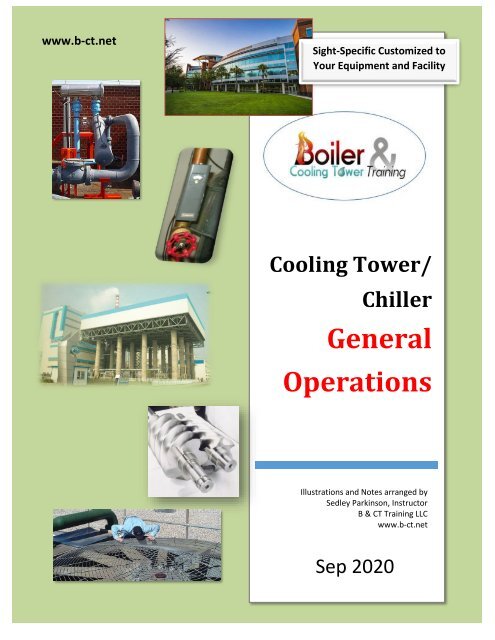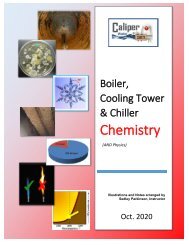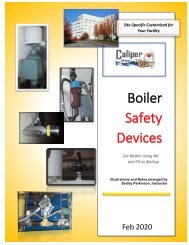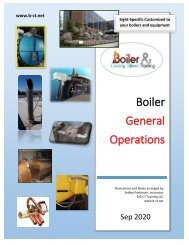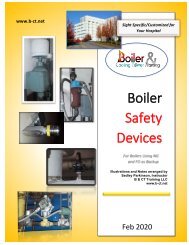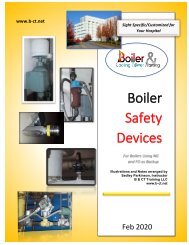Cooling Towers 9.30.20
Create successful ePaper yourself
Turn your PDF publications into a flip-book with our unique Google optimized e-Paper software.
www.b-ct.net<br />
Sight-Specific Customized to<br />
Your Equipment and Facility<br />
<strong>Cooling</strong> Tower/<br />
Chiller<br />
General<br />
Operations<br />
Illustrations and Notes arranged by<br />
Sedley Parkinson, Instructor<br />
B & CT Training LLC<br />
www.b-ct.net<br />
Sep 2020
Contents<br />
Fluid Dynamics ........................................................................................................................................................................ 3<br />
Valves .................................................................................................................................................................................. 3<br />
Water Hammer: Valve Induced....................................................................................................................................... 5<br />
Backflow Prevention ....................................................................................................................................................... 6<br />
Pumps.............................................................................................................................................................................. 7<br />
Water Flow Dynamics and Electricity Correlation .......................................................................................................... 9<br />
Psi ...................................................................................................................................................................................... 10<br />
Vapor Pressure .............................................................................................................................................................. 10<br />
Pressure Measurement ................................................................................................................................................. 12<br />
Ideal Gas Law ................................................................................................................................................................ 13<br />
Heat Pumps ................................................................................................................................................................... 14<br />
Water ................................................................................................................................................................................ 17<br />
°F vs. Btu ........................................................................................................................................................................ 17<br />
Steam Table................................................................................................................................................................... 22<br />
Water to Ice Expansion ................................................................................................................................................. 23<br />
pH .................................................................................................................................................................................. 24<br />
Aquastat ........................................................................................................................................................................ 25<br />
Antifreeze ...................................................................................................................................................................... 26<br />
Pressure Reducing Valve (PRV) ..................................................................................................................................... 28<br />
Heat Exchangers ............................................................................................................................................................ 31<br />
Electricity ............................................................................................................................................................................... 32<br />
DC vs AC ............................................................................................................................................................................ 32<br />
VFD: Affinity Law ............................................................................................................................................................... 33<br />
LEED Program .................................................................................................................................................................... 34<br />
Thermocouples ................................................................................................................................................................. 35<br />
The Grid ............................................................................................................................................................................. 36<br />
<strong>Cooling</strong> <strong>Towers</strong>: Dynamics .................................................................................................................................................... 37<br />
Saturation Curve ........................................................................................................................................................... 37<br />
Evaporative <strong>Cooling</strong> ...................................................................................................................................................... 40<br />
Relative Humidity .......................................................................................................................................................... 41<br />
Psychrometric Chart ...................................................................................................................................................... 42<br />
Size: Tonnage ................................................................................................................................................................ 44<br />
<strong>Cooling</strong> Tower Types ..................................................................................................................................................... 45<br />
<strong>Cooling</strong> Tower Components .............................................................................................................................................. 50<br />
pg. 1
Fill .................................................................................................................................................................................. 50<br />
Water Level Controllers ................................................................................................................................................ 53<br />
Immersion Heaters ........................................................................................................................................................ 54<br />
<strong>Cooling</strong> Tower Scale .......................................................................................................................................................... 55<br />
Source: CaCO 3 and Silica ............................................................................................................................................... 55<br />
Prevention ..................................................................................................................................................................... 56<br />
Scale Removal ............................................................................................................................................................... 58<br />
Corrosion ........................................................................................................................................................................... 59<br />
Galvanic Corrosion ........................................................................................................................................................ 59<br />
Rust ............................................................................................................................................................................... 60<br />
Biological Growth ............................................................................................................................................................ 62<br />
Algae, Yeast, Molds ...................................................................................................................................................... 62<br />
Legionella ..................................................................................................................................................................... 63<br />
Chillers ................................................................................................................................................................................. 69<br />
History .............................................................................................................................................................................. 69<br />
Basic Composition ........................................................................................................................................................... 70<br />
Refrigerants ....................................................................................................................................................................... 75<br />
Corrosion ........................................................................................................................................................................... 78<br />
MIC ................................................................................................................................................................................ 78<br />
Eddie Current Testing ................................................................................................................................................. 80<br />
Chiller Compressor Types ................................................................................................................................................. 81<br />
Absorption <strong>Cooling</strong> ........................................................................................................................................................... 89<br />
Ammonia/Hydrogen Refrigeration ............................................................................................................................... 89<br />
Lithium Bromide (LiBr) Absorption Chillers .................................................................................................................. 90<br />
Free <strong>Cooling</strong> ...................................................................................................................................................................... 91<br />
Chiller Surge ...................................................................................................................................................................... 92<br />
pg. 2
Fluid Dynamics<br />
Valves<br />
Ball<br />
Gate<br />
Butterfly<br />
Globe<br />
Pressure Regulators<br />
are usually globe<br />
valves<br />
Diaphragm<br />
Stem pushes down on<br />
rubber gasket<br />
Spring Check<br />
Swing<br />
Check<br />
Lift<br />
Check<br />
pg. 3
Actuators remotely open and close valves<br />
Manual override<br />
Motorized actuators close slowly,<br />
avoiding water hammer<br />
A Solenoid is an electric actuator: electricity creates a<br />
temporary magnet pushing the permanent magnet down.<br />
pg. 4
Water Hammer: Valve Induced<br />
pg. 5
Backflow Prevention<br />
Symbol<br />
Backflow means the undesirable reversal of flow of a<br />
liquid, gas or solid into the potable water supply.<br />
Back-siphonage occurs when higher pressure fluids, gases,<br />
or suspended solids move to an area of lower pressure<br />
fluids.<br />
Q.: How often does the backflow prevention assembly<br />
need to be tested?<br />
A.: On installation and at least once a year thereafter by<br />
a licensed backflow tester.<br />
pg. 6
Chemical Feed Pumps<br />
Pumps<br />
Speed:<br />
How often<br />
Chemical<br />
injection<br />
quill<br />
Stroke:<br />
How deep<br />
Check<br />
valve<br />
Peristaltic Chemical Feed Pumps<br />
Pinch process does not lose prime, but<br />
tube needs to be replaced periodically<br />
pg. 7
Feed Water Pumps<br />
Horizontal Screw Feed Water Pumps<br />
Vertical Multistage<br />
(multiple impellers)<br />
Feed Water Pumps<br />
Also called a “can pump”<br />
(like a tin can)<br />
Parallel Connection:<br />
flow increase constant pressure<br />
Series Connection:<br />
pressure increase constant flow<br />
pg. 8
Water Flow Dynamics and Electricity Correlation<br />
Parallel:<br />
Amps increase, volts stay the same<br />
Series:<br />
Volts increase, amps stay the same<br />
Volts measure how hard the electricity is pushing (Electrical Force)<br />
Amps measure current, or how much electricity is flowing [Ah = Amp-hours]<br />
Watts measure how much electricity is going through the circuit (Power)<br />
Ohms (Ω) measures Resistance<br />
Note correlation<br />
Pressure: psi → Volts<br />
Flow: gpm → Amps<br />
Hydraulic HP → Watts<br />
252 calories = 1 Btu<br />
1 ft 3 of natural gas ≈ 1020 Btu<br />
1 kilowatt·hr (kwh) of electricity = 3413 Btu<br />
1 pound of Coal ≈ 9,200 Btu<br />
1 pound of gasoline ≈ 14,300 Btu<br />
1 pound of diesel or fuel oil ≈ 16,000 Btu<br />
1 Therm = 100,000 Btu<br />
1 Dekatherm (DTH) = 1,000,000 Btu<br />
0.293 Watts = 1 Btu/hr<br />
pg. 9
Psi<br />
Absolute Zero = Perfect Vacuum<br />
Vapor Pressure<br />
0<br />
Vacuum<br />
Maximum water<br />
content in air =<br />
saturation point<br />
Evaporation or<br />
Vaporization<br />
Vaporization ><br />
Condensation<br />
Vaporization =<br />
Condensation<br />
Equilibrium<br />
Pressure changes with Temperature (molecules<br />
move around more when heated)<br />
Saturation Point<br />
(Equilibrium) changes with<br />
Temperature and Pressure<br />
and becomes the<br />
Saturation Curve<br />
pg. 10
Atmospheric vs Gauge<br />
psig<br />
(gauge)<br />
psia<br />
(absolute)<br />
H 2O<br />
boiling pt<br />
Perfect Vacuum -14.7 0 °F<br />
Near Vacuum -14.5 0.2 53°<br />
Mt. Everest -5.6 9.1 157°<br />
Lake Tahoe -3.0 11.7 200.7°<br />
Sea Level 0 14.7 212°<br />
Dead Sea 0.8 15.5 215°<br />
Space = a vacuum<br />
psia = 0<br />
psig = -14.7<br />
Sea Level =<br />
1 atmosphere<br />
= 14.7 psia<br />
= 0 psig<br />
Mt. Everest = 29,029 ft<br />
LakeTahoe= 6224 ft<br />
Dead Sea = -1378 ft<br />
High altitude cooking instructions: 3500 to 6500 ft<br />
Increase simmer time to 19 min (with lower boiling<br />
temperature, it takes longer to cook food.)<br />
Vacuum<br />
pump<br />
Vacuum<br />
jar<br />
pg. 11
Pressure Measurement<br />
Bourdon Tube Gauges: flattened<br />
hollow tubes that s-t-r-e-t-c-h out<br />
when introduced to pressure.<br />
Digital pressure<br />
gauges do not<br />
need a pig tail<br />
and can<br />
automatically log<br />
measurements<br />
into a computer.<br />
Compound gauges measure both pressure<br />
and vacuum. Note: inches of mercury<br />
(a perfect vacuum = 30” Hg)<br />
0 psia = -1 bar (metric) = -100 kPa (metric)<br />
1 atm = 100 kPa = 1013 mbars = 760 mmHg = 30 inHg = 14.7 psia = 0 psig<br />
Vacuum gauge<br />
pg. 12
Ideal Gas Law<br />
When Temperature↑ and Volume stays the same, then Pressure↑<br />
= BOILER<br />
When Pressure↑ and Volume stays the same, then Temperature↑ = AIR COMPRESSOR<br />
The INTERCOOLER uses water or<br />
outside air to cool compressed<br />
air in-between stages.<br />
2 nd Stage<br />
1 st Stage<br />
When Pressure↓ and Volume stays the same, then Temperature↓ = Propane Tank<br />
ICE !<br />
P↓ × V c = T↓ : Refrigeration<br />
(Restricting Orifice)<br />
Hot<br />
Cold<br />
Various types of expansion valves<br />
Air Conditioning<br />
* Simplified for training purposes. Actual:<br />
pg. 13
Heat Pumps<br />
Around 37°F many heat pumps reach what is<br />
called the balance point where the heat pump<br />
needs to run constantly to maintain a<br />
comfortable indoor temperature. Efficiency<br />
drops as you approach this point.<br />
Reversing Valve<br />
pg. 14
Dehumidifier<br />
DEHUMIDIFIER<br />
Wood Dehumidification Kiln<br />
HVAC Dehumidification Air Handler<br />
pg. 15
Temperature<br />
: through nonmoving or solid parts<br />
: through moving substances, such<br />
as water, steam, or air<br />
: through energy waves, even<br />
travels through a vacuum (such as the sun<br />
transfers heat to Earth through space)<br />
Latent heat of<br />
liquefaction<br />
Latent heat of<br />
vaporization<br />
vaporizing →<br />
BTUs<br />
Latent Heat:<br />
BTUs<br />
← condensing<br />
pg. 16
Temperature<br />
Water<br />
°F vs. Btu<br />
@ 0 psig = 1 Atm = sea level<br />
Saturated Steam = steam at the boiling pt.<br />
Superheated<br />
(above the<br />
boiling pt.)<br />
32°F 212°F<br />
0°C 100°C<br />
970.3 BTUs to boil 1 # of H 2O<br />
Water at 32°F<br />
contains 0 BTUs<br />
(beginning point for<br />
BTU measurement)<br />
-144BTU 0BTU 180BTU 1150.3BTU<br />
Heat Content<br />
1 BTU = heat needed to change 1 lb. of water 1º F<br />
To change 1 lb of:<br />
Ice 1º F, add 0.5 Btu<br />
Steam 1º F, add 0.45 Btu<br />
How many BTUs does one pound of steam contain at 212°F at Sea Level?<br />
32 ºF water to 212 ºF water takes 180BTU/lb. 180<br />
212 ºF water to 212 ºF steam takes 970.3BTU/lb. +970.3<br />
1150.3 BTUs<br />
pg. 17
Sea Level<br />
Pressure<br />
Phases of Water<br />
°F vs psi<br />
Pressure vs. Temperature<br />
Freeze Point<br />
Curve<br />
Evaporation<br />
Curve<br />
14.7 psia<br />
= 0 psig<br />
= 1 atm<br />
= 1 bar<br />
Solid<br />
Sea Level<br />
Vapor<br />
Triple<br />
Point<br />
(not to scale)<br />
Absolute Zero<br />
(Theoretical)<br />
Temperature<br />
32°F<br />
0°C<br />
212°F<br />
100°C<br />
Solid<br />
Triple<br />
Point<br />
Vapor<br />
Where Freeze Point Curve, Evaporation Curve and Sublimation Curves Meet<br />
= 0.09psia and 32.02°F<br />
pg. 18
Freeze Dryers<br />
Home Unit<br />
Freeze Dryer<br />
Sublimation<br />
= Freeze Dryers<br />
Low temperature and pressure<br />
Vacuum<br />
Chamber<br />
2. About 90% of the food’s<br />
moisture is drawn off by<br />
sublimating the ice at<br />
temperature as low as -60º F<br />
pg. 19
Water to Vapor Expansion<br />
When Temperature ↑ and Pressure stays the same, then Volume must ↑<br />
v = 0.01672 ft 3<br />
Now imagine a 500 gallon boiler rupturing and instantly filling the<br />
building with 111,700 ft 3 (100 hot air balloons) of flash steam<br />
1865 Sultana<br />
2000 returning Union<br />
POW’s died from boiler<br />
explosion<br />
Denver: 500 gallon boiler explosion<br />
Today, the most common reasons<br />
for boiler explosions are improper<br />
purge cycle and low water cut-off<br />
failure.<br />
pg. 20
Cavitation:<br />
Implosion of low pressure steam bubbles back to water<br />
causing miniature shock waves, damaging metal surface.<br />
Propeller Cavitation<br />
Valve Cavitation:<br />
sounds like gravel<br />
moving through pipe<br />
pg. 21
Psig<br />
Inches of Hg (Vacuum)<br />
Steam Table<br />
Gauge<br />
Pressure<br />
Psia<br />
Boiling<br />
Point<br />
ºF<br />
Btu content of<br />
1 lb. of water<br />
at B.P.<br />
Btu needed to<br />
turn 1 lb. of water<br />
at B.P. into steam<br />
Btu content<br />
of saturated<br />
steam<br />
Volume<br />
of water<br />
ft 3 /lb<br />
Volume<br />
of steam<br />
ft 3 /lb<br />
29.7 0.09 32 0 1075.8 1075.8 0.01602 3306<br />
29.5 0.2 53 21 1063.8 1085.0 0.01603 1526<br />
27.9 1.0 102 70 1036.3 1106.0 0.01614 334<br />
19.7 5.0 162 130 1001.0 1131.0 0.01641 73.5<br />
9.6 10.0 193 161 982.1 1143.3 0.01659 38.4<br />
7.5 11.0 198 166 979.3 1145.0 0.01665 35.1<br />
5.5 12.0 202 170 976.6 1146.6 0.01667 32.4<br />
3.5 13.0 206 174 974.2 1148.1 0.01667 30.1<br />
1.4 14.0 210 178 971.9 1149.5 0.01670 28.0<br />
0 14.7 212 180 970.3 1150.3 0.01672 26.8<br />
1 15.7 216 184 967 1152 0.01675 24.8<br />
2 16.7 219 187 965 1153 0.01677 23.4<br />
5 19.7 227 196 960 1156 0.01683 20.1<br />
10 24.7 240 208 952 1160 0.01692 16.3<br />
15 29.7 250 219 945 1164 0.01700 13.8<br />
20 34.7 259 228 939 1167 0.01708 11.9<br />
25 39.7 267 236 933 1170 0.01714 10.5<br />
30 44.7 274 243 928 1172 0.01721 9.4<br />
40 54.7 287 256 919 1176 0.01732 7.8<br />
50 64.7 298 267 911 1179 0.01743 6.7<br />
60 74.7 307 277 904 1182 0.01752 5.8<br />
70 84.7 316 286 898 1184 0.01761 5.2<br />
80 94.7 324 295 891 1186 0.01769 4.7<br />
90 104.7 331 302 886 1188 0.01777 4.2<br />
100 114.7 337 309 880 1189 0.01785 3.9<br />
110 124.7 344 316 875 1191 0.01792 3.6<br />
120 134.7 350 322 870 1192 0.01799 3.3<br />
130 144.7 355 328 866 1193 0.01806 3.1<br />
140 154.7 360 333 861 1195 0.01812 2.9<br />
150 164.7 366 339 857 1196 0.01818 2.7<br />
200 214.7 388 362 837 1199 0.01847 2.1<br />
250 264.7 406 382 820 1202 0.01873 1.7<br />
etc.↓ 300 417 394 809 1203 0.01890 1.54<br />
400 446 424 781 1205 0.01934 1.16<br />
450 456 437 767 1205 0.01955 1.03<br />
500 467 449 755 1204 0.01975 0.93<br />
600 486 472 732 1203 0.02013 0.77<br />
900 532 527 669 1195 0.02123 0.50<br />
1200 567 572 612 1183 0.02232 0.36<br />
1500 596 612 556 1167 0.02346 0.28<br />
2000 636 672 463 1135 0.02565 0.19<br />
2500 668 731 361 1191 0.02860 0.13<br />
2700 680 756 312 1068 0.03027 0.11<br />
3206.2 705 903 0 903 0.05053 0.05053<br />
Sea Level<br />
Supercritical Steam refers to conditions<br />
above 3206.2 psia and 705 °F where steam<br />
and water reach a new phase.<br />
pg. 22
Water to Ice to Expansion Ice<br />
Expansion<br />
slightly<br />
negative<br />
9 %<br />
slightly<br />
positive<br />
slightly<br />
positive<br />
Water to Ice Volume Expands 10%<br />
Which is about the same as:<br />
10 ft 3 water making 11 ft 3 of ice<br />
Hexagonal shape<br />
60°<br />
…, and Ice Floats<br />
(less dense)<br />
60°<br />
Breweries have high steam demand<br />
…, and breaks lines<br />
pg. 23
pH<br />
Hydrochloric Acid<br />
(HCl)<br />
H + OH -<br />
10 0 = 1 = 100%<br />
10 -14 = .00000000000001<br />
Stomach Acid<br />
(weak HCl)<br />
10 -1 = .1 = 10%<br />
10 -13 = .0000000000001<br />
Vinegar<br />
Lemon Juice<br />
10 -2 = .01 = 1%<br />
10 -12 = .000000000001<br />
The concept of pH was<br />
first introduced in 1909<br />
by Danish chemist<br />
Soda Pop<br />
Orange Juice<br />
10 -3 = .001 = .1%<br />
10 -11 = .00000000001<br />
Tomato Juice<br />
Acid Rain<br />
10 -4 = .0001 = .01%<br />
10 -10 = .0000000001<br />
Eye Drops<br />
Normal Rain<br />
10 -5 = .00001<br />
10 -9 = .000000001<br />
Saliva<br />
Urine<br />
10 -6 = .000001<br />
10 -8 = .00000001<br />
Pure Water<br />
10 -7 = .0000001 =<br />
10 -7 = .0000001<br />
Sea Water<br />
Swimming Pools<br />
10 -8 = .00000001<br />
10 -6 = .000001<br />
Baking Soda<br />
10 -9 = .000000001<br />
10 -5 = .00001<br />
Great Salt Lake<br />
10 -10 = .0000000001<br />
10 -4 = .0001<br />
Ammonia (NH4OH)<br />
Soaps<br />
10 -11 = .00000000001<br />
10 -12 = .000000000001<br />
10 -3 = .001<br />
10 -2 = .01<br />
At pH > 7, OH -<br />
(hydroxide) becomes<br />
the active ion.<br />
Bleach<br />
Oven Cleaner<br />
10 -13 = .0000000000001<br />
10 -1 = .1<br />
OH -<br />
Drain Cleaner<br />
Caustic (NaOH)<br />
10 -14 = .00000000000001<br />
H +<br />
10 0 = 1<br />
HCl (acid) + NaOH (base) → H 2O (pH 7) + NaCl<br />
(salt water)<br />
pg. 24
Aquastat<br />
Aquastat sets hot water<br />
boiler temperature ranges<br />
STRAP-ON SURFACE<br />
TEMPERATURE PROBE<br />
Temperature probe bulb<br />
fits into thermowell.<br />
Low Limit:<br />
Turns on the burner<br />
view from inside vessel<br />
Differential:<br />
Normal operating range<br />
above low limit (turns off burner)<br />
Triple Aquastat<br />
High Limit:<br />
Safety Cutoff<br />
Manual reset indicates this is a high<br />
temperature limit safety cutoff<br />
pg. 25
Temperature °F<br />
Antifreeze<br />
Prevents freezing in Closed Loops<br />
during shut downs.<br />
Refractometers use light to<br />
measure glycol’s freeze point<br />
PG<br />
C₃H₈O₂<br />
Composition<br />
EG<br />
C2H6O2<br />
Food Grade<br />
(You can drink it)<br />
Safety<br />
Toxic<br />
(Follow proper use and<br />
disposal guidelines)<br />
Nitrites are added to prevent<br />
corrosion.<br />
Cost (as of 2014)<br />
Inhibitor = Nitrites<br />
= corrosion prevention<br />
Because of safety, food-processing closed loop<br />
boilers generally are charged with Propylene<br />
Glycol.<br />
Use<br />
Because of cost, nonfood-processing closed loop<br />
boilers generally are charged with Ethylene Glycol.<br />
Glycols<br />
@
Steam Trap Trouble Shooting<br />
Pyrometer<br />
A significant drop in temperature<br />
indicates that a steam trap is<br />
functioning properly.<br />
Thermal Imager<br />
pg. 27
P↓ × Pressure V c = T↓ (Ideal Reducing Gas Law) Valve (PRV) Restricting Orifice<br />
Manual-Bolt<br />
adjust<br />
Auto-Pressurestatic adjust<br />
Auto-Thermostatic<br />
adjust<br />
Hollow Capillary<br />
Tubes<br />
Steam Pressure/Temperature Reducers<br />
operate on the exact same principles as<br />
Chiller/AC TXVs<br />
Wood drying kiln<br />
Internally Equalized<br />
pg. 28<br />
Externally Equalized
Demineralizer (DeMin Water)<br />
Not only softens the water by removing positive ions such as Ca +2 and Mg +2 but<br />
also removes undesired negative ions such as SO 4<br />
-2<br />
, Cl - , CO 3<br />
-2<br />
, HCO -3 .<br />
Single Bed Demineralizer<br />
Regeneration<br />
Mixed Bed Demineralizer<br />
pg. 29
Reverse Osmosis (Membrane Filtration)<br />
No salt or other chemicals are needed, however,<br />
the costs of replacement membranes, the<br />
electricity needed to pump the water through the<br />
membranes, and the excess higher concentration<br />
waste water all need to be calculated in when<br />
considering this form of water treatment.<br />
pg. 30
Heat Exchangers<br />
U-Tube<br />
= Two pass<br />
Shell and Tube<br />
Straight Tube =<br />
One pass<br />
Plate and Frame<br />
BPHE: Brazed Plate Heat Exchanger<br />
No gaskets<br />
Higher efficiency means<br />
equivalent heat transfer can be<br />
achieved with smaller units<br />
pg. 31
Electricity<br />
DC vs AC<br />
Error! Bookmark not defined.<br />
Tesla vs. Edison<br />
Direct Current:<br />
One Way Flow<br />
Single Phase AC<br />
Alternating Current: Switches Back and<br />
Forth from Positive to Negative<br />
Hertz = rotations per second<br />
Three Phase AC<br />
pg. 32
VFD: Affinity Law<br />
Variable Frequency Drive<br />
The Affinity Law<br />
Law 1a) Air flow is directly proportional to fan speed.<br />
Example: When fan speed doubles, air flow doubles.<br />
1a) Fan Speed ↑ = Air Flow ↑<br />
Law 1b) Torque increase is proportional to the square of the fan speed increase.<br />
Example: When fan speed doubles, torque increases four times<br />
When fan speed triples, torque increases nine times 1b) (Fan Speed ↑ ) 2 = Torque ↑<br />
Law 1c) Power required is proportional to the cube of fan speed increase.<br />
Example: When fan speed doubles, power required is six times<br />
1c) (Fan Speed ↑ )<br />
When fan speed triples, power required is 27 times<br />
3 = Power ↑<br />
Significant Energy Savings<br />
Use only the fan speed your system is calling for.<br />
A 100 HP fan running at half speed uses the<br />
same energy as a 13 HP motor!<br />
(½) 3 x 100HP = (1/8) x 100HP = 13HP<br />
Equipment Savings<br />
Single-speed motors start abruptly:<br />
High starting torque<br />
High starting current surges (up to 8 times)<br />
Variable speed drives gradually ramp up the motor.<br />
pg. 33
LEED Program<br />
In the United States and in a number of<br />
other countries around the world, LEED<br />
certification is the recognized standard for<br />
measuring building sustainability.<br />
Four Certification Levels<br />
pts possible)<br />
The LEED green building rating system -- developed<br />
and administered by the U.S. Green Building<br />
Council, a Washington D.C.-based, nonprofit<br />
coalition of building industry leaders -- is designed<br />
to promote design and construction practices that<br />
increase profitability while reducing the negative<br />
environmental impacts of buildings and improving<br />
occupant health and well-being.<br />
Out of 110 possible points<br />
LEED certification is helping to steer the HVAC industry towards higher efficient<br />
boilers and chillers. In the long run, these systems pay for themselves.<br />
<br />
☺<br />
Out <br />
In ☺<br />
pg. 34
Thermocouples<br />
A small electric current is<br />
created when heated.<br />
Thermopile:<br />
End bulb has multiple wire “twistings”,<br />
produces larger electron flow.<br />
Thermocouple:<br />
Single twisted wire sensor<br />
Temperature probe<br />
Thermopile<br />
Pilot<br />
Copper capillary tube protects the inner<br />
insulated wire and also conducts electricity<br />
back to the head where voltage can be<br />
measured (usually in millivolts).<br />
Spark Ignitor<br />
Common in<br />
atmospheric burners<br />
pg. 35
The Grid<br />
the Grid<br />
Base Load Power Plants run<br />
continuously while Intermediate and<br />
Peak Plants meet local load demands<br />
Transmission<br />
Energy Losses<br />
pg. 36
<strong>Cooling</strong> <strong>Towers</strong>: Dynamics<br />
Saturation Curve<br />
Saturation Curve<br />
1000gH20 / Kg Air<br />
all air is water vapor<br />
Equilibrium = Saturation Curve = Dew Point<br />
Water vapor in air<br />
400g<br />
300g<br />
200g<br />
100g<br />
0 K= -273°C= -460°F<br />
No water vapor in air<br />
No molecular movement<br />
Absolute zero temperature<br />
temperature increase →<br />
373 K=100°C=212°F<br />
All water vaporized<br />
(@0psig)<br />
0g<br />
Water droplets, suspended in the air,<br />
form as humid air temperature drops<br />
past the saturation curve.<br />
←temperature drop<br />
H 2O falls out as dew and frost,<br />
OR rain and snow.<br />
f<br />
r<br />
o<br />
s<br />
t<br />
d<br />
e<br />
w<br />
Freeze Point<br />
pg. 37
Air Moisture Content →<br />
Adiabatic Process<br />
Moist air rises over mountains: lower air pressure,<br />
vapor condenses on dust particles forming<br />
suspended droplets or ice crystals (clouds).<br />
Descending clouds increase in<br />
air pressure, clouds evaporate<br />
back into vapor = Rain Shadow.<br />
Rain/Snow →<br />
Temperature Increase →<br />
Same principle applies<br />
to large air masses<br />
pg. 38
Extreme<br />
Precipitation<br />
A combination of the adiabatic process and<br />
the inability of cold air to hold moisture, the<br />
Dry Valleys of Antarctica is said not to have<br />
any measurable precipitation for over<br />
2,000,000 years.<br />
The Brahmaputra Mountains in Eastern<br />
India reports the highest average rainfall of<br />
467 inches per year.<br />
pg. 39
Evaporative <strong>Cooling</strong><br />
Rapid expansion of volume during phase change (liquid to gas) =<br />
temperature drop, the lost energy is carried away by vapor molecules.<br />
Evaporation<br />
Saturation Point,<br />
the air can’t hold<br />
any more water.<br />
(Wet Bulb)<br />
New Higher<br />
Air Moisture<br />
Content<br />
Original Air<br />
Moisture<br />
Content<br />
New Lower Air<br />
Temperature<br />
Original Air<br />
Temperature<br />
Direct Evaporative <strong>Cooling</strong><br />
(effectiveness reduced in high humidity)<br />
pg. 40
Relative Humidity<br />
Relative Humidity<br />
100% 1 Kg H2O/Kg air<br />
= pure steam<br />
80% 800g/Kg air<br />
% Relative Humidity = Water<br />
content of air compared to<br />
how much water the air could<br />
hold at that temperature.<br />
50%<br />
40%<br />
30%<br />
20%<br />
10%<br />
500g/Kg air<br />
400g/Kg air<br />
300g/Kg air<br />
200g/Kg air<br />
100g/Kg air<br />
Absolute zero<br />
The higher the<br />
temperature, the<br />
more water the air<br />
can hold.<br />
100ºC<br />
Boiling Point at sea level<br />
< 100% RH: evaporation can still take place and temperature drops.<br />
Wet Bulb represents maximum possible<br />
evaporation temperature drop.<br />
100% Relative Humidity =<br />
Saturation Curve<br />
pg. 41
Psychrometric Chart<br />
Psychrometry<br />
Sling Psychrometer<br />
Digital Psychrometer<br />
(accuracy may vary, depending on model)<br />
Incoming Air<br />
Dry Bulb = 90°F<br />
@10% RH<br />
Outgoing Air<br />
Wet Bulb = 60°F<br />
@100% RH<br />
pg. 42
pg. 43
AC Size: Tonnage<br />
- 144 BTU / lb.<br />
The unit of measure used in air conditioning<br />
to describe the cooling capacity of a system.<br />
One ton of cooling is based on the amount<br />
of heat needed to melt (or freeze) one ton<br />
(2000 lbs.) of ice in a 24 hour period.<br />
1 ton cooling = 2000 lbs. x 144 BTU/lb.<br />
= 288,000 BTU/day<br />
= 12,000 BTU/hr.<br />
1000 to 5000 ton water cooled<br />
(capacity depends on RH)<br />
1 ton window AC<br />
50 ton rooftop air cooled<br />
Dry <strong>Cooling</strong><br />
No water evaporation<br />
Dry cooling can only reach<br />
down to dry bulb temperature.<br />
pg. 44
<strong>Cooling</strong> Tower Types<br />
Natural Draft <strong>Cooling</strong> <strong>Towers</strong><br />
(no electric fans)<br />
Hyperboloid Natural Draft <strong>Cooling</strong> <strong>Towers</strong>:<br />
patented in 1918<br />
hot moist air ↑<br />
Natural Draft <br />
cool air →<br />
pg. 45
Forced Draft <strong>Cooling</strong> <strong>Towers</strong><br />
pg. 46
Induced Draft <strong>Cooling</strong> <strong>Towers</strong><br />
FRP<br />
FRP = Fiber Reinforced Plastic (Fiberglass)<br />
PVC = Polyvinylchloride<br />
Wood Frame<br />
HDPE = High Density Polyethylene Plastic (Recycled)<br />
pg. 47
Cross Flow<br />
Fill Basin<br />
Splash<br />
Guards<br />
Counter Flow<br />
Drift<br />
Eliminator<br />
pg. 48
Open Recirculating<br />
<strong>Cooling</strong> Tower<br />
Fill<br />
Drift Eliminator<br />
Closed Recirculating<br />
<strong>Cooling</strong> Tower<br />
Radiator Insert<br />
Galvanized steel<br />
Closed system:<br />
Notice pipe locations<br />
pg. 49
<strong>Cooling</strong> Tower Components<br />
Fill<br />
Drift Eliminators<br />
Blade<br />
Cellular<br />
Packaged Film Fill<br />
hot water in↓<br />
hot water in↓<br />
moist air out↑<br />
hot water in↓<br />
moist air out↑<br />
moist air<br />
out<br />
cold water out↓<br />
dry air in↑<br />
cold water out↓<br />
dry air in↑<br />
cold water out↓<br />
dry air in↑<br />
pg. 50
Stackable Sheet Film Fill<br />
pg. 51
Splash Fill<br />
Horizontal<br />
V Bars<br />
Ladder<br />
Looking from the bottom up<br />
Looking from the top down<br />
pg. 52
Water Level<br />
Water Level Controllers<br />
Controllers<br />
Electric Sensor<br />
Controller<br />
Hi<br />
Alarm<br />
Hi<br />
Lo<br />
Ground<br />
Pumps &<br />
valves<br />
Conductive Liquid<br />
Ball Float<br />
Slide<br />
Diaphragm<br />
Equilibrium<br />
pg. 53
Immersion<br />
Heaters<br />
Immersion Heaters<br />
Prevents winter freezing<br />
Thermowells protect thermometers<br />
hollow<br />
pg. 54
<strong>Cooling</strong> Tower SCALE<br />
<strong>Cooling</strong> Tower Scale<br />
Source: CaCO3 and Silica<br />
CaCO3<br />
Calcium Carbonate<br />
Mg(OH) 2<br />
Magnesium Hydroxide<br />
CaSO 4<br />
Calcium Sulfate<br />
SiO 2<br />
Silica<br />
Side stream Filter<br />
pg. 55
Hardness →<br />
SCALE Prevention CONTROL #1<br />
Bleed Off<br />
Stay under the saturation point. Keep the cycles<br />
of concentration in check by using bleedoff<br />
controls.<br />
Scale<br />
forms<br />
Saturation<br />
maximum<br />
Supersaturated<br />
Conductivity<br />
set point.<br />
1 cycle<br />
= raw water<br />
2 cycles<br />
= twice as concentrated<br />
due to evaporation<br />
3 cycles<br />
= three times<br />
4 cycles<br />
Electric Motor Actuator slowly opens<br />
(helps prevent water hammer)<br />
Signals actuator to bleed off<br />
system until conductivity drops<br />
Inline probe measures<br />
how well electricity flows<br />
between electrodes in<br />
water then converts<br />
reading to Conductivity.<br />
Electromagnetic<br />
Solenoid<br />
pg. 56
Hardness→<br />
OH¯ Concentration→<br />
SCALE CONTROL #2<br />
Phosphates and pH<br />
Use scale control chemicals.<br />
Polymers/HEDP keep crystals in suspension.<br />
Phosphonates disrupt formation of crystal lattices.<br />
Nalco solid chemical dissolver/dispenser<br />
New maximum<br />
Proper use of chemicals<br />
raises the saturation line,<br />
enabling higher cycles and<br />
water conservation.<br />
Supersaturated<br />
New conductivity<br />
set point.<br />
Old saturation<br />
maximum<br />
From 2.5<br />
to 3.4 cycles<br />
1 cycle 2 cycles<br />
3 cycles<br />
4 cycles<br />
SCALE CONTROL #3<br />
IF pH is high, add acid.<br />
High concentration of<br />
OH¯ ions (high pH)<br />
lowers the solubility of<br />
calcium carbonate, it<br />
precipitates out and scale<br />
forms.<br />
Scale<br />
forms<br />
7 pH → 9 10 11 12 13 14<br />
pg. 57
Scale Removal<br />
Pressure Spray & Vacuum<br />
CaCO 3 + 2HCl (acid) CaCl 2 + H 2 O + CO 2 (gas)<br />
Dilute HCl<br />
Scale Chips<br />
Acid<br />
(Inhibited with Nitrites)<br />
Municipalities generally do not accept pH
Cathode<br />
Corrosion<br />
Galvanic Galvanic<br />
Corrosion<br />
Corrosion<br />
mild steel vs stainless steel<br />
brass vs steel<br />
Metal<br />
Oxides↓<br />
Cathode<br />
(zero corrosion)<br />
Anode<br />
e -<br />
Cathode<br />
(zero corrosion)<br />
Metal<br />
Oxides→<br />
Anode<br />
e -<br />
Anode<br />
Tubercles<br />
←(zero corrosion)<br />
Cathodic ←<br />
→Anodic<br />
Plastic/Nylon<br />
sleeves/gaskets<br />
More anodic→ corrodes first<br />
←Further apart, stronger galvanic effect→<br />
Coated bolts/screws<br />
Dielectric Union<br />
pg. 59
Rust<br />
Dissolved oxygen “steels” (oxidizes) electrons<br />
from Iron. A weak but significant electrical<br />
current forms creating Anode (+) and<br />
Cathode (-) areas.<br />
O 2 + 4e¯+ 2H 2O → 4OH¯<br />
Fe +2<br />
Anode<br />
2e¯<br />
Cathode<br />
Fe +2 ions are released into the water along with<br />
the newly formed OH¯ ions.<br />
Fe +2<br />
Fe<br />
Anode<br />
Cathode<br />
Fe +2 combines with 2OH¯ and precipitates out as rust.<br />
Fe +2 + 2OH¯ → Fe(OH) 2<br />
rust<br />
rust<br />
Cathode<br />
Fe<br />
Fe<br />
Cathode<br />
Anode<br />
Iron Rust<br />
White Rust = Zinc rust on<br />
galvanized metal<br />
(selective leeching).<br />
pg. 60
H + Concentration→<br />
.<br />
Acidic waters have high H + ion concentrations which react with electrons at<br />
the cathode releasing hydrogen gas: 2H + + 2e¯ → H 2 (g).<br />
Corrosion is accelerated.<br />
0 ← pH 3 5 7<br />
Group VII<br />
Halogens<br />
Like Oxygen, the halides Bromine, Chlorine and Iodine are<br />
also “looking” for electrons which are readily available at the<br />
cathode. At high levels, these oxidizing biocides have a<br />
tendency to cause corrosion.<br />
Oxidizing<br />
Biocides<br />
Road Salt (NaCl) Corrosion<br />
pg. 61
Biological Growth<br />
Algae, Yeast, Molds<br />
Unchecked mold and algae growth restricts air<br />
flow plugs lines and ultimately reduces efficiency.<br />
pg. 62
Legionella Bacteria<br />
History<br />
The first recognized outbreak occurred at the Bellevue Stratford during an American<br />
Legion conference in 1976 in Philadelphia. As many as 221 people were given<br />
medical treatment, and 34 died from extreme pneumonia symptoms. The U.S.<br />
Centers for Disease Control and Prevention mounted an unprecedented investigation<br />
and, by September, the focus had shifted from outside causes, such as a disease<br />
carrier, to the hotel itself. After 5 months of research, the Legionellosis bacterium<br />
was finally identified; it was in the cooling tower. Normally, the bacterium dies<br />
when the water droplets in the mist spray leaving the cooling tower dries up in the air.<br />
However, at the Stratford, the mist spray from the cooling tower exhaust fans was<br />
being sucked back in by the building’s fresh air intake!<br />
Major Legionella Outbreaks<br />
Non-communicable<br />
(cannot be transferred<br />
between humans)<br />
Year Location Cases Died Bacteria Source<br />
1976 Philadelphia 221 34 <strong>Cooling</strong> Tower<br />
1985 Stafford, UK 175 28 <strong>Cooling</strong> Tower<br />
1999 Bovenkarspel, Netherlands 200 32 Humidifier & Whirlpool<br />
2000 Melbourne, Australia 125 4 <strong>Cooling</strong> Tower<br />
2001 Murcia, Spain 449 6 <strong>Cooling</strong> Tower<br />
2002 Barrow, UK 172 7 <strong>Cooling</strong> Tower<br />
2003 Pas-de-Calais, France 86 18 <strong>Cooling</strong> Tower<br />
2005 Fredrikstad, Norway 56 10 Air Scrubber<br />
2011 Playboy Mansion, Los Angeles 123 0 Hot Tub<br />
Due to early<br />
intervention<br />
Legionella are more<br />
difficult to kill in areas<br />
with high slime build up.<br />
Between 1995 and 2005, over 32,000<br />
worldwide cases of Legionnaires'<br />
disease and more than 600 outbreaks<br />
were reported to the European Working<br />
Group for Legionella Infections (EWGLI).<br />
pg. 63
Infected lung<br />
Water test<br />
Urine test<br />
pg. 64
BIOCIDES<br />
Oxidizing antimicrobials kill by “stealing” electrons from critical atoms<br />
disrupting internal functions or damaging cell walls.<br />
Nonoxidizing kill by replacing critical molecules with “poison” molecules.<br />
Oxidizing<br />
Biocides<br />
Chlorine, Bromine, and Iodine “steel” (oxidize)<br />
electrons from molecules of living cells and<br />
they die or fail to reproduce.<br />
Note: No. 53 Iodine (I)<br />
is also a medicinal<br />
disinfectant.<br />
Hypochlorite Ion<br />
Hypochlorous Acid<br />
Chlorine Gas/ Tablets /Bleach + H 2 O → OCl ¯ + HOCl + OH¯<br />
Ions attack<br />
cell walls.<br />
Acids attack<br />
internal cell<br />
functions.<br />
Bromine Tablets + H 2 O →<br />
OBr ¯ + HOBr + OH¯<br />
Chlorine<br />
Hypobromite Ion<br />
Hypobromous Acid<br />
Bromine<br />
Nalco OxySlugger dispenser<br />
pg. 65
Oxidizing Biocides<br />
Ozone (O3)<br />
e¯<br />
1) 1) Generated on site and does not<br />
require storage.<br />
2)<br />
2)You cannot over-dose as unused<br />
ozone escapes out of the water and<br />
reverts to oxygen.<br />
3) Disinfection qualities are not<br />
dependent on pH, nor does the<br />
addition affect the pH of water.<br />
4) Effectiveness can be measured with<br />
an ORP (Oxidation/Reduction<br />
Potential) meter.<br />
5) Less corrosive than chlorine and<br />
bromine in water.<br />
6) Works well for areas with naturally<br />
soft water.<br />
Ozone is a strong oxidizing<br />
biocide that attacks cell walls<br />
pg. 66
Oxidizing Biocides<br />
Sodium Hypochlorite =<br />
NaClO<br />
Bleach: Inexpensive but decomposes<br />
with heat and light.<br />
Solution: On site bleach generator. MIOX ®<br />
Salt (NaCl) + Electricity (via electrolysis) = Bleach<br />
pg. 67
Nonoxidizing<br />
Biocides<br />
Surface Acting<br />
Quaternary ammonium<br />
compounds (quats) are<br />
cationic surface-active<br />
molecules. They damage<br />
the cell walls of bacteria,<br />
fungi, and algae. The cell<br />
“bleeds” and dies.<br />
Metabolism (internal) Acting<br />
Many antimicrobials interfere with energy metabolism inside the cell. The cell gets “sick”<br />
and cannot reproduce. The following are examples of these types of biocides:<br />
organotins<br />
bis(trichloromethyl) sulfone<br />
methylenebis(thiocyanate) (MBT)<br />
Beta-bromo-Beta-nitrostyrene (BNS)<br />
dodecylguanidine salts<br />
bromonitropropanediol (BNPD)<br />
pg. 68
Chillers<br />
History<br />
By using a mixture of alcohol and ether,<br />
Benjamin Franklin, along with John Hadley<br />
of Cambridge, dropped room temperature<br />
down to 7℉.<br />
“From this experiment, one may see the<br />
possibility of freezing a man to death on<br />
a warm summer day.” B.F.<br />
History<br />
Oliver Evans designed the first<br />
vapor air-conditioning machine,<br />
but never made one.<br />
1834<br />
Jacob Perkins, using Evans design, was first to<br />
patented the air conditioner, but never made one.<br />
In 1902, Willis Carrier built<br />
the first working chiller.<br />
1920’s<br />
< 1920’s:<br />
Simple Ice Box<br />
Monitor Top<br />
(compressor on top)<br />
pg. 69
Basic Composition<br />
pg. 70
Psi →<br />
Btus/pound →<br />
pg. 71
Expansion Valve<br />
Thermostatic<br />
Expansion Valve<br />
( = TEV = TXV )<br />
Electric<br />
Expansion<br />
Valve<br />
Orifice Plate<br />
Expansion<br />
Valve<br />
Low Load<br />
High Load<br />
Float<br />
Expansion<br />
Valve<br />
pg. 72
Liquid Line Filter Drier<br />
Refrigerant Oil Filter<br />
pg. 73
Chiller<br />
Economizer<br />
pg. 74
Refrigerants<br />
Refrigerants<br />
It is suspected that a variety of biological<br />
consequences such as increases in sunburn, skin<br />
cancer, cataracts, damage to plants, and reduction of<br />
certain plankton in the ocean may result from the<br />
increased UV-B exposure due to ozone depletion.<br />
Image of the largest Antarctic<br />
ozone hole recorded (September<br />
2006), over the Southern pole.<br />
1920’s Sulfur Dioxide . . . . . . . Corrosive, Toxic<br />
Methyl Formate . . . . . Flammable, Toxic<br />
Ammonia . . . . . . . . . . . Toxic<br />
1930’s Chlorofluorocarbons Ozone Depletion<br />
CFC’s<br />
1960’s Hydrochloroflourocarbons Ozone Depletion<br />
HCFC’s<br />
1990’s Hydrofluorocarbons Safe<br />
HFC’s<br />
CFCs: Banned in US and Canada HCFCs: Being phased out HFCs: OK<br />
pg. 75
Refrigerants (continued)<br />
>>>>CFC refrigerants<br />
CARBON, FLORINE, CHLORINE.<br />
Banned from use or production within all<br />
countries covered by the Montreal<br />
Protocol.<br />
>>>>HCFC refrigerants<br />
HYDROGEN, CARBON, FLORINE, CHLORINE.<br />
Being phased out.<br />
>>>>HFC refrigerants<br />
HYDROGEN, FLORINE, CARBON.<br />
HFC’s contain no chlorine:<br />
NO OZONE DEPLETION.<br />
It is estimated that the Ozone layer will<br />
revert back to its original level by 2050!<br />
pg. 76
ANHYDROUS<br />
= Contains no water<br />
Being Phased Out<br />
Acceptable<br />
Natural Refrigerants:<br />
R717 Ammonia NH 3 BP -28°F<br />
R290 Propane C 3H 8 BP -44°F<br />
R600a Iso-butane C 4H 10 BP 11°F<br />
R600 Butane C 4H 10 BP 31°F<br />
R744 Carbon Dioxide CO 2 BP -109°F<br />
Azeotrope<br />
- A mixture made up of two or more refrigerants<br />
with similar boiling points that act as a single fluid.<br />
The components of azeotropic mixtures will not<br />
separate under normal operating conditions and<br />
can be charged as a vapor or liquid.<br />
Zeotrope<br />
- A mixture made up of two or more refrigerants<br />
with different boiling points which creates a<br />
boiling point “glide”. Therefore: Zeotropic<br />
mixtures should be charged in the liquid state.<br />
pg. 77
Corrosion<br />
MIC<br />
MIC<br />
Microbiologically Induced Corrosion<br />
Biofilm = Slime<br />
Under the slime is an<br />
area where Anerobic<br />
bacteria thrive.<br />
Cathode<br />
←e¯<br />
M +<br />
Anode<br />
e¯→ Cathode<br />
Anaerobic bacteria “eat” metal by means<br />
of reduction reaction.<br />
Its waste is food for the aerobic bacteria in the<br />
slime. These colonies form tubercles.<br />
Aerobic = breaths 0xygen<br />
Anaerobic = does not breath O2<br />
Tubercle grows,<br />
penetrating completely<br />
through metal.<br />
←e¯<br />
↑<br />
M +<br />
e¯→<br />
Upon removing Tubercles,<br />
shiny, raw metal is exposed.<br />
pg. 78
MIC Prevention and control<br />
Water Treatment Biocides + Non-penetrable, Non-metallic Coatings<br />
Fouling prevention and control<br />
Manually “punching ” tubes<br />
Automatically punching tubes<br />
pg. 79
Eddie Current Testing<br />
Cracks, corrosion, or other imperfections<br />
create out of specification signals.<br />
pg. 80
Chiller Compressor Types<br />
Positive Displacement<br />
Reciprocating<br />
Single Acting<br />
Double Acting<br />
pg. 81
Rotary<br />
Single Screw<br />
Double Screw<br />
pg. 82
TXV<br />
Oil separator<br />
Economizer<br />
pg. 83<br />
Auto shut valves
Scroll<br />
Vane<br />
pg. 84
Dynamic<br />
Centrifugal<br />
pg. 85
Because of the high boiling point, lowpressure<br />
chillers evaporate the refrigerant<br />
in vacuum conditions<br />
Beacause of the nature of a vacuum, sometimes non-refrigerant<br />
gas (air) leaks in (is sucked in).<br />
Low Pressure Centrifugal Chiller Purge Unit<br />
Removes and vents non-condensable gases and at the same<br />
time, returns refrigerant as a liquid to chiller condenser.<br />
Compressor<br />
Filter drier<br />
Safety Burst Disc<br />
Pneumatically controlled shutoff valves<br />
pg. 86
Centrifugal:<br />
Magnetic Bearing<br />
Computer controlled lead lag<br />
alternates operating compressor for<br />
even, on-demand use<br />
When the chiller is operated in cooling mode, the<br />
condensed liquid refrigerant exits the electronic<br />
expansion valve (4), and enters the<br />
bottom of the flooded evaporator, where it is<br />
evenly dispersed along the length of the<br />
evaporator by the use of a distributor plate (3).<br />
Liquid refrigerant inside the evaporator at low<br />
pressure then makes contact with the copper<br />
tubes that the building’s water runs through,<br />
exchanges heat to the refrigerant, and vaporizes<br />
it (2) at the suction pressure of the compressor<br />
(1). As a result of the lower density of the vapor<br />
and the suction of the compressor, the vaporized<br />
refrigerant gas is then drawn to the top of the<br />
evaporator through the mist eliminators (5). (Mist<br />
eliminators inhibit minute liquid particles<br />
entrained in the vaporized refrigerant, from<br />
entering the compressor). Passing through the<br />
(pre-rotation) inlet guide vanes (6), the vaporized<br />
refrigerant then enters the compressor inlet (7),<br />
where the angle of incidence of the refrigerant<br />
hitting the first stage impeller, is altered, thereby<br />
allowing a higher compression efficiency for a<br />
given compressor rotor speed.<br />
No lubricating oil needed.<br />
Electronically Controlled TXV<br />
pg. 87
Hermetic and<br />
Semi Hermetic<br />
Hermetic<br />
piston<br />
scroll<br />
Hermetic = air tight, not designed to be opened. Design<br />
helps prevent contamination of edibles.<br />
Semi Hermetic = air tight, but designed to enable access<br />
to inside components.<br />
Semi Hermetic<br />
pg. 88
Absorption <strong>Cooling</strong><br />
Ammonia/Hydrogen Refrigeration<br />
Evaporating ammonia cools off,<br />
travels along tube and is reabsorbed<br />
by the water.<br />
COLD<br />
COLD<br />
Hydrogen<br />
Electric Heater Driven<br />
RV Propane Driven<br />
pg. 89
Lithium Bromide (LiBr) Absorption Chillers<br />
Water is used as a<br />
refrigerant. At very low<br />
psi, it will not freeze.<br />
Evaporation chamber is<br />
maintained @<br />
0.24 in. Hg = 0.12 psia.<br />
At this pressure (closely<br />
above the triple point),<br />
water boils at 39°F<br />
producing chilled process<br />
water in the coil.<br />
pg. 90
Free <strong>Cooling</strong><br />
When conditions are favorable, significant ∆T can be achieved<br />
and energy is saved by simply bypassing the chiller.<br />
pg. 91
Chiller Chiller Surge Surge<br />
If heat is not removed sufficiently from the condenser, then the<br />
refrigerant will build up pressure resisting the compressor and, in<br />
some extreme cases, flow backwards against the compressor!<br />
Normal flow<br />
Compressor<br />
SURGE: Too high of pressure in condenser,<br />
forces backflow, damaging chiller.<br />
Evaporator<br />
Condenser<br />
high psi<br />
Possible Causes:<br />
Poor water circulation to cooling tower: plugged filters, pump failure<br />
<strong>Cooling</strong> tower fan failure<br />
Scale and or biological growth build-up in condenser (no heat transfer)<br />
Heavy fouling in cooling tower media (cooled water not being produced)<br />
In some extreme cases, the evaporator has gotten too cold and forms a vacuum<br />
(example: chilled water demand drops suddenly)<br />
Monitor Approach Temperatures<br />
Evaporator Approach is the difference between the evaporating refrigerant temperature, measured at the<br />
well in the evaporator, and leaving chilled water temperature.<br />
Condenser Approach is the difference between the liquid refrigerant temperature, as measured on the<br />
liquid line, and leaving condenser water temperature.<br />
Take all readings with the water cooled chiller at full load.<br />
pg. 92
4 Funtion Valve, 7<br />
4<br />
A<br />
Absolute Zero, 10, 18, 37, 41<br />
Absorption Chiller, 90<br />
Absorption <strong>Cooling</strong>, 89<br />
AC, 32<br />
Acid, 24<br />
Actuator, 4, 56<br />
Adiabatic Process, 38<br />
Aerobic, 78<br />
Affinity Law, 33<br />
Air Conditioner, 13, 14<br />
Algae, 62<br />
Alkaline, 24<br />
Alternating Current, 32<br />
American Legion, 63<br />
Ammonia, 24<br />
Ammonia/Hydrogen Refrigeration, 89<br />
Amps, 9<br />
Anerobic, 78<br />
Anion, 29<br />
Anode, 59, 60<br />
Antarctica, 39<br />
Antifreeze, 26<br />
Aquastat, 23, 25<br />
Atm, 17<br />
Azeotrope, 77<br />
Back Siphonage, 6<br />
Backflow, 6<br />
Bacteria, 26, 78<br />
Balance Point, 14<br />
Ball Valve, 3<br />
Bar, 12<br />
Barometer, 12<br />
Base, 24<br />
Base Load, 36<br />
Bellevue Stratford Hotel, 63<br />
Benjamin Franklin, 69<br />
BHP, 9<br />
Biocide, 65<br />
Bleach, 65, 67<br />
Boiling Point, 11, 17, 22<br />
Bourdon-Tube, 12<br />
BPHE, 31<br />
Brahmaputra Mountains, 39<br />
Braized Plate, 31<br />
Bromine, 61, 65<br />
BTU, 17, 22<br />
BTU Content, 22<br />
CaCO3, 55<br />
Calcium Carbonate, 55<br />
B<br />
C<br />
Calcium Sulfate, 55<br />
Cambridge, 69<br />
Can pump, 8<br />
Cathode, 59, 60, 61<br />
Cation, 29<br />
Cavitation, 21<br />
Centrifugal Compressor, 85<br />
CFCs, 75, 77<br />
Cherrapunjee, 39<br />
Chiller Surge, 92<br />
Chillers, 69<br />
Chlorine, 61, 65, 76<br />
Closed Recirculating <strong>Cooling</strong> Tower, 49<br />
Coal, 9<br />
Compound Guage, 12<br />
Compressor, 13<br />
Condensate, 12<br />
Condensation, 10, 18<br />
Conduction, 16<br />
Controllers, 25<br />
Convection, 16<br />
Critical Pressure and Temperature, 22<br />
Cross corrugated, 50<br />
Cross flow, 48<br />
DC, 32<br />
Dead Sea, 11<br />
Dehumidifier, 15<br />
Delta T, 91<br />
Demineralize, 29<br />
Deposition, 18<br />
Dew, 37<br />
Diaphragm feed pump, 7<br />
Dielectric Union, 59<br />
Direct Current, 32<br />
Direct Evaporative <strong>Cooling</strong>, 40<br />
Double Acting Compressor, 81<br />
Double Screw Compressor, 82<br />
Drift eliminator, 50<br />
Dry bulb, 41, 42<br />
Dry Valleys, 39<br />
Dynamic Compressor, 85<br />
Economizer, 74<br />
Eddie Current, 80<br />
Edison, Thomas, 32<br />
Electrodes, 56<br />
Electrolysis, 67<br />
Electromagnet, 56<br />
Equilibrium, 10, 37<br />
Ethylene Glycol, 26<br />
Evaporation, 10, 18<br />
exothermic, 41<br />
Expansion Valve, 13<br />
Expansion, water to ice, 23<br />
Explosion, 20<br />
D<br />
E
Feed Water Pumps, 8<br />
Fiber reinforced plastic, 47<br />
Film Fill, 51<br />
Filter Drier, 73<br />
Flash Steam, 20<br />
Float Expansion Valve, 72<br />
Food Grade Antifreeze, 26<br />
Foot Valve, 7<br />
Forced draft, 46<br />
Fouling, 50<br />
Free cooling, 91<br />
Freeze Drier, 19<br />
Freeze Point, 26<br />
Fridgidair, 69<br />
Frost, 37<br />
FRP, 47<br />
Fuel Oil, 9<br />
Galvanic corrosion, 59<br />
Galvanized Steel, 49<br />
General Electric, 69<br />
Glide, 77<br />
Glycol, 26<br />
gravel, 21<br />
Grid, 36<br />
Halides, 61<br />
Hamburger Helper, 11<br />
HCFCs, 75, 77<br />
HDPE, 47<br />
Heat Exchanger, 31<br />
Heat Pump, 14<br />
HEDP, 57<br />
Hermetic, 88<br />
Hexagonal, 23<br />
HFCs, 75, 77<br />
High density polyethylene, 47<br />
Hot Air Balloon, 20<br />
Hydrofluorocarbons, 75<br />
Hydrogen, 24<br />
Hydroxide, 24<br />
Hyperbolic, 45<br />
Hypobromous Acid, 65<br />
Hypochlorous Acid, 65<br />
Ideal Gas Law, 13, 20, 28<br />
Immersion heater, 54<br />
Impeller, 21, 85<br />
Induced draft, 47<br />
F<br />
G<br />
H<br />
I<br />
Induction Coil, 80<br />
Intercooler, 13<br />
Iodine, 65<br />
Jacob Perkins, 69<br />
John Hadley, 69<br />
Kiln, 15<br />
Ladder, 52<br />
Lake Tahoe, 11<br />
Latent heat, 44<br />
LEED, 34<br />
Legionella, 63, 64<br />
LiBr, 90<br />
Lithium Bromide Chiller, 90<br />
Low Water Cutoff, 20<br />
Magnetic Bearing Chiller, 87<br />
Melting, 18<br />
Membrane, 30<br />
Mercury Switch, 25<br />
Metabolism, 68<br />
MIC, 78, 79<br />
Mold, 62<br />
Monitor Top, 69<br />
Mono Lake, 57<br />
Mt. Everest, 11<br />
Multistage Pump, 8<br />
Myox, 67<br />
Neutral Water, 24<br />
Nitrites, 26<br />
Non-metallic Coating, 79<br />
J<br />
K<br />
L<br />
M<br />
N<br />
O<br />
Ohms, 9<br />
Oil Filter, 73<br />
Old Faithful, 17<br />
Oliver Evans, 69<br />
Open Recirculating <strong>Cooling</strong> Tower, 49<br />
Oriface Plate Expansion Valve, 72<br />
ORP, 66<br />
Oxides, 59<br />
Oxidizing, 65<br />
Ozone, 66<br />
pg. 94
Ozone Layer, 75<br />
Parrallel pumps, 8<br />
Pascal, 12<br />
Peristaltic Feed Pump, 7<br />
pH, 24<br />
Phases of Water, 17<br />
Philadelphia, 63<br />
Phosphates, 57<br />
Pickup Coil, 80<br />
Pigtale Loop, 12<br />
Pilot, 35<br />
Plate and Frame, 31<br />
Polyvinylchloride, 47<br />
Precipitation, 39<br />
Pressure vs. Heat Content Chart, 71<br />
Pressure/Temperature Reducing Valve, 28<br />
Pressurestat, 25<br />
Pressuretrol, 25<br />
Priming Valve, 7<br />
Propane Tank, 13<br />
Propeller, 21<br />
Propylene Glycol, 26<br />
psia, 11, 12<br />
psig, 11, 12, 17<br />
Psychrometer, 42<br />
Psychrometric Chart, 41, 43<br />
Punching Tubes, 79<br />
Purge Cycle, 20<br />
PV=nRT, 13<br />
PV=T, 13, 20<br />
PVC, 47<br />
Pyrometer, 27<br />
Quaternary ammonia, 68<br />
Quill, 7<br />
Radiant Heat, 16<br />
Radiation, 16<br />
Reduced Pressure Zone, 6<br />
Refractometer, 26<br />
Refrigeration, 13<br />
Regeneration, 29<br />
Relative Humidity, 41, 42<br />
Resin Beads, 29<br />
Resistance, 9<br />
Restricting Orifice, 28<br />
Reverse Osmosis, 30<br />
Reversing Valve, 14<br />
RH, 42<br />
RO, 30<br />
P<br />
Q<br />
R<br />
Rotary Compressor, 82<br />
Rust, 60, 61<br />
Sand Filter, 55<br />
Saturated Steam, 17<br />
Saturation Curve, 10, 37<br />
Saturation Point, 10, 40, 56<br />
Scale, 57<br />
Scroll Compressor, 84<br />
Sea level, 19<br />
Sea Level, 11, 17, 18, 22<br />
Semi hermetic, 88<br />
Sensible Heat, 16<br />
Series Connection, 9<br />
Series Pumps, 8<br />
Shell and Tube, 31<br />
Side Stream Filter, 55<br />
Silica, 55<br />
sine wave, 32<br />
Single acting compressor, 81<br />
Single phase, 32<br />
Single Screw Compressor, 82<br />
Siphon Loop, 12<br />
Slime, 78<br />
Snap Switch, 25<br />
Sodium Hypochlorite, 67<br />
Solenoid, 4, 56<br />
Sørensen, Søren, 24<br />
Spark Ignitor, 35<br />
Splash fill, 52<br />
Splash guards, 48<br />
Steam Table, 22<br />
Step Down Transformer, 36<br />
Step Up Transformer, 36<br />
Stethoscope, 27<br />
Stroke, 7<br />
Sublimation, 18, 19<br />
Sultana, 20<br />
Supercritical Steam, 22<br />
Superheated Steam, 17<br />
Surge, 92<br />
Termperature Glide, 77<br />
Tesla, Nickola, 32<br />
TEX Valve, 72<br />
Thermal Imager, 27<br />
Thermocouple, 35<br />
Thermopile, 35<br />
Thermowell, 25, 54<br />
Three phase, 32<br />
Tom Thumb, 9<br />
Tonnage, 44<br />
Torque, 33<br />
S<br />
T<br />
pg. 95
Transformer, 36<br />
Transmission, 36<br />
Triple Point, 18, 90<br />
Tubercle, 78<br />
TXV, 72<br />
VFD, 33<br />
Volts, 9<br />
Volute, 85<br />
W<br />
Vacuum, 10, 11, 12, 19<br />
Vacuum Gauge, 12<br />
Vane Compressor, 84<br />
Vanes, 84<br />
Vapor Pressure, 10<br />
Vaporization, 10<br />
Variable Frequency Drive, 33<br />
V-bars, 52<br />
Vertical offset, 50<br />
V<br />
Water hammer, 5<br />
Water level indicator, 53<br />
Watts, 9<br />
Wet bulb, 41, 42<br />
White rust, 60<br />
Willis Carrier, 69<br />
Zeotrope, 77<br />
Z<br />
pg. 96


